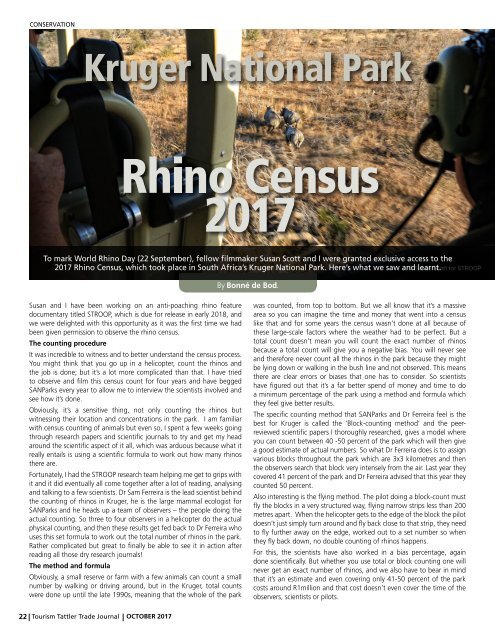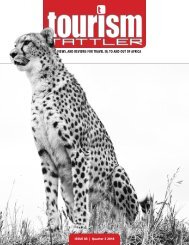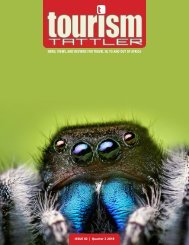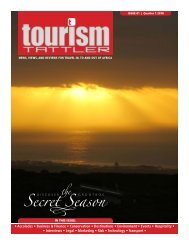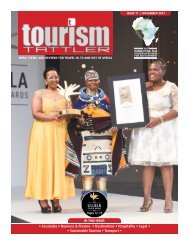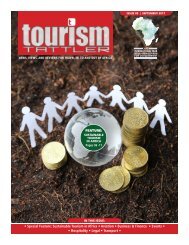Tourism-Tattler-October-2017
Create successful ePaper yourself
Turn your PDF publications into a flip-book with our unique Google optimized e-Paper software.
CONSERVATION<br />
To mark World Rhino Day (22 September), fellow filmmaker Susan Scott and I were granted exclusive access to the<br />
<strong>2017</strong> Rhino Census, which took place in South Africa’s Kruger National Park. Here’s what we saw and learnt.<br />
By Bonné de Bod.<br />
Susan and I have been working on an anti-poaching rhino feature<br />
documentary titled STROOP, which is due for release in early 2018, and<br />
we were delighted with this opportunity as it was the first time we had<br />
been given permission to observe the rhino census.<br />
The counting procedure<br />
It was incredible to witness and to better understand the census process.<br />
You might think that you go up in a helicopter, count the rhinos and<br />
the job is done; but it’s a lot more complicated than that. I have tried<br />
to observe and film this census count for four years and have begged<br />
SANParks every year to allow me to interview the scientists involved and<br />
see how it’s done.<br />
Obviously, it’s a sensitive thing, not only counting the rhinos but<br />
witnessing their location and concentrations in the park. I am familiar<br />
with census counting of animals but even so, I spent a few weeks going<br />
through research papers and scientific journals to try and get my head<br />
around the scientific aspect of it all, which was arduous because what it<br />
really entails is using a scientific formula to work out how many rhinos<br />
there are.<br />
Fortunately, I had the STROOP research team helping me get to grips with<br />
it and it did eventually all come together after a lot of reading, analysing<br />
and talking to a few scientists. Dr Sam Ferreira is the lead scientist behind<br />
the counting of rhinos in Kruger, he is the large mammal ecologist for<br />
SANParks and he heads up a team of observers – the people doing the<br />
actual counting. So three to four observers in a helicopter do the actual<br />
physical counting, and then these results get fed back to Dr Ferreira who<br />
uses this set formula to work out the total number of rhinos in the park.<br />
Rather complicated but great to finally be able to see it in action after<br />
reading all those dry research journals!<br />
The method and formula<br />
Obviously, a small reserve or farm with a few animals can count a small<br />
number by walking or driving around, but in the Kruger, total counts<br />
were done up until the late 1990s, meaning that the whole of the park<br />
was counted, from top to bottom. But we all know that it’s a massive<br />
area so you can imagine the time and money that went into a census<br />
like that and for some years the census wasn’t done at all because of<br />
these large-scale factors where the weather had to be perfect. But a<br />
total count doesn’t mean you will count the exact number of rhinos<br />
because a total count will give you a negative bias. You will never see<br />
and therefore never count all the rhinos in the park because they might<br />
be lying down or walking in the bush line and not observed. This means<br />
there are clear errors or biases that one has to consider. So scientists<br />
have figured out that it’s a far better spend of money and time to do<br />
a minimum percentage of the park using a method and formula which<br />
they feel give better results.<br />
The specific counting method that SANParks and Dr Ferreira feel is the<br />
best for Kruger is called the ‘Block-counting method’ and the peerreviewed<br />
scientific papers I thoroughly researched, gives a model where<br />
you can count between 40 -50 percent of the park which will then give<br />
a good estimate of actual numbers. So what Dr Ferreira does is to assign<br />
various blocks throughout the park which are 3x3 kilometres and then<br />
the observers search that block very intensely from the air. Last year they<br />
covered 41 percent of the park and Dr Ferreira advised that this year they<br />
counted 50 percent.<br />
Also interesting is the flying method. The pilot doing a block-count must<br />
fly the blocks in a very structured way, flying narrow strips less than 200<br />
metres apart. When the helicopter gets to the edge of the block the pilot<br />
doesn’t just simply turn around and fly back close to that strip, they need<br />
to fly further away on the edge, worked out to a set number so when<br />
they fly back down, no double counting of rhinos happens.<br />
For this, the scientists have also worked in a bias percentage, again<br />
done scientifically. But whether you use total or block counting one will<br />
never get an exact number of rhinos, and we also have to bear in mind<br />
that it’s an estimate and even covering only 41-50 percent of the park<br />
costs around R1million and that cost doesn’t even cover the time of the<br />
observers, scientists or pilots.<br />
22 <strong>Tourism</strong> <strong>Tattler</strong> Trade Journal<br />
OCTOBER <strong>2017</strong>


